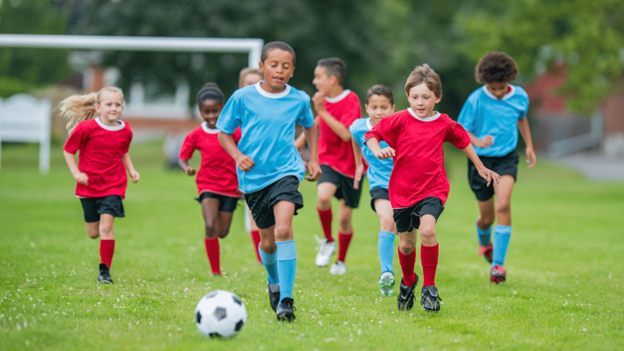
Soccer injuries in kids: common types and when to seek treatment.
Picture this: your kid hobbles off the soccer field and you're trying not to panic. Is this something that needs a doctor, or will ice and rest do the trick? Every soccer parent faces this moment at some point.
Soccer sends about 88,000 kids and teens to emergency rooms each year, making it one of the top sports for youth injuries. But most soccer injuries aren't serious emergencies.
Knowing what you're dealing with helps you respond the right way.
Most common soccer injuries in youth players.
Ankle sprains.
Ankle sprains happen constantly in soccer. Kids land funny after headers, get tangled up with other players, or step in holes. Mild sprains hurt and swell a bit, but your child can usually walk on them.
More serious ones involve major swelling and trouble putting weight on the foot.
Knee injuries.
Knee problems pop up when players pivot quickly or collide with others. Minor strains make the knee feel tight or achy, especially when bending.
But if you hear a "pop" during play and the knee swells fast, that's a red flag.
Cuts and scrapes.
Cuts and scrapes are soccer injuries that come with the territory.
Most can be handled at home with soap, water and a bandage. However, deep cuts that won't quit bleeding or have stuff stuck in them need medical attention.
Muscle strains.
Muscle strains hit the hamstrings, quads and calves when kids sprint hard or skip warm-ups. Mild ones feel like tight, crampy muscles.
Severe strains cause sharp pain and visible swelling.
Growing pains.
Growing pains sometimes masquerade as injuries. These usually hurt below the kneecap and bother kids more at night.
Soccer injuries are just one concern for active kids. Our health and wellness blog covers everything from asthma management during sports to recognizing when playground bumps need medical attention.
Soccer injury prevention: gear, warm-ups and safety tips.
- Good cleats prevent a ton of slips and falls. Make sure they actually fit and work for the field conditions your child plays on.
- Shin guards aren't just league requirements. Shin guards stop serious lower leg injuries from kicks and collisions. Same goes for proper socks that cover the guards completely.
- Dynamic warm-ups beat static stretching every time. Light jogging, leg swings and soccer-specific movements get kids ready to play safely.
- Hydration starts way before game time. Kids should sip water all day, not just when they're dying of thirst on the field.
- Field checks by coaches and parents can catch holes, debris, or slippery spots before someone gets hurt.
- Age-appropriate rules, like smaller fields and goals for younger players cut down on collision injuries significantly.
When soccer injuries need urgent care vs. sideline treatment.
- Handle at home. Minor scrapes (clean with soap and water), mild muscle soreness (rest and ice), small bruises and general tiredness after tough games.
- Emergency Room. For head trauma with associated loss of consciousness, confusion, vomiting, severe headache or any neurologic symptoms; visible deformity of the injured area, severe cut, with difficulty controlling bleeding, severe dehydration.
- Urgent care. For minor head trauma, without other red flag symptoms, suspected fractures without obvious complications, lacerations needing stitches, sprains, strains, mild dehydration
Here's the bottom line: most soccer injuries in kids heal up just fine with the right approach. When you're not sure whether to worry, it's always better to get it checked out.
At CityMD, we see soccer injuries all the time and can quickly figure out what needs treatment versus what's safe to monitor at home. No appointment needed and we're here to keep your young athlete healthy and back on the field.

We’re ready to care for you.
Visit any CityMD urgent care location in your community today for an evaluation with one of our expert providers.